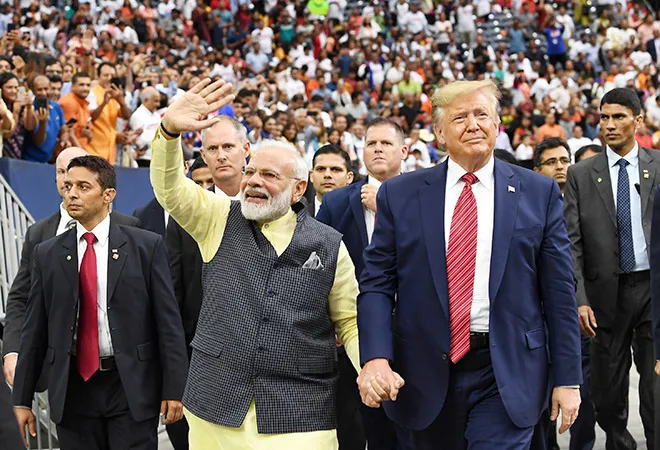In February 1964, the Beatles made their first appearance in the United States. Landing in New York, they were greeted by a rapturous crowd -- Beatlemania had hit America. It is tempting to see Prime Minister Narendra Modi’s ‘Howdy, Modi!’ frenzy as a political equivalent. The pop-star entry and applause, the double act with US President Donald Trump -- for semiotics and substance, optics and opportunities, the events at the NRG Stadium in Houston, Texas -- will keep analysts busy for some time to come.
Anybody who was at the stadium would have marvelled at the energy and sheer electricity. Much more than of two global politicians, ‘Howdy, Modi! was a celebration of the Indian community in the US. From truck drivers to tech tycoons, from motel owners to doctors, from academics to stand-up comics and chefs, this community is diverse -- as diverse as the society of its ancestors, and as diverse as the society where it lives. It is a high-achieving community, respected in the US, adding value to the economy and social fabric of America. It is also an exceptional ambassador of the Indian ethic.
Without this community, there would have been no show. Modi would not have had the essential ingredient for his argument -- that while the Indian community in the US is different from India as a nation, in their own ways both are assets and trusted partners for the US. As for Trump, minus Indian American success, he would not have found it worth his while to resort to political and electoral outreach to a minority community he so pointedly identified with American values.
Both leaders were delivering, and will take away, multiple messages. It is crucial to separate the domestic and diplomatic strands of three broad messages, as well as two caveats. On the relationship with India, Trump sent two messages. First, he acknowledged India’s case as a victim of cross-border terrorism rooted in Islamic/Islamist radicalism. This has been done earlier by past US presidents, but rarely with such bluntness.
Trump also linked India’s attempts to secure its borders against infiltration to the well-being of the country and its people. It would be too imaginative to interpret this as an endorsement of the National Register of Citizens (NRC). More likely, Trump had Pakistan and terrorism in mind, and was recognising the validity of India’s recent changes in the legal and political architecture of Jammu-Kashmir and Ladakh. Combined with the petering out of the Pakistani community’s protests -- trucks outside mosques were reportedly empty as Houston Police warned that protestors who broke the law would have their visa status reviewed -- this was a ringing endorsement of Modi’s moves on Article 370.
Second, Trump spoke a constructive, win-win language on trade. This is rare for him, as he likes to appear as a trade bully. In Houston, he appreciated Indian purchase of US defence equipment and Texas’ very own oil and gas. He specifically thanked Indian investment for creating jobs in the US -- not in information technology (IT), as would have been expected some years ago, but with a specific reference to an Indian company’s investment in a steel facility in Ohio. This was an example from manufacturing, close to Trump’s heart and to that of his blue-collar base.
Trump was also quick to emphasise the investment relationship was ‘reciprocal’, and US companies were also investing in India. This is as normal and regular a language on business, trade and investment as can be used.
Trump’s third message was domestic. Immigration is a contested word in the US today, not least because Trump has made it so and targeted particular groups of migrants. On Sunday, he was almost gushing about the Indian community as a hard-working, tax-paying, law-abiding cohort. To some degree, this will inoculate the community from the ugly rhetoric of US identity politics that will inevitably surface before the 2020 election.
Of course, much depends on what the community does from now on, and how it leverages its emergent political profile. Modi has raised the community’s status and indicated the potential of its collective weight. He cannot do more. The rest is for US citizens to organise and take ahead.
What are the caveats? There are two. The easy one is that Trump is unpredictable, and could easily say something contradictory in a matter of days. This is possible, but even for him, a complete roll-back of the narrative of ‘Howdy, Modi!’ would be difficult.
Caveat two is more nuanced. Despite the hand-in-hand walkaround, for Modi, Trump is an instrument, not a goal. In Houston, he played to Trump’s fixations, even his vanities, and structured a programme, a process and a phenomenon that intrigued and attracted POTUS.
Five years ago, he had worked very differently to achieve very similar results with Barack Obama -- a man for whom Modi still cares very deeply. The Martin Luther King-Mahatma Gandhi montage that preceded the Trump-Modi appearance and the Indian prime minister’s participation at the UN Climate Action Summit later this week are legacies of that earlier camaraderie. That the prime minister who so persevered to establish a connection with Obama has now made the same effort with Trump demonstrates a larger axiom -- for Modi the US relationship is strategic, it is not ideological.
This commentary originally appeared in The Economics Times.
The views expressed above belong to the author(s). ORF research and analyses now available on Telegram! Click here to access our curated content — blogs, longforms and interviews.




 PREV
PREV


